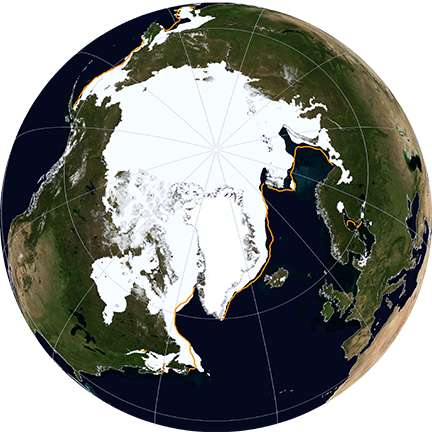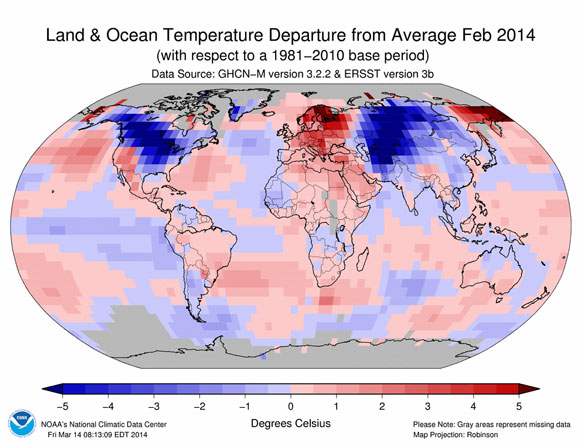
Arctic sea ice reached its maximum extent for this year on March 21, 2014, according to a report from the National Snow and Ice Data Center. The extent of Arctic sea ice this year was the fifth lowest on record, these scientists say. Surprised? We in the U.S., Canada and Russia had a cold winter this year, in contrast to recent years. However, compared to February temperatures from 1981 to 2010, air temperatures in some parts of the Arctic were actually above average in the winter of 2013-14. Additionally, air temperatures throughout much of the Arctic during late March were about 2 to 6 degrees Celsius (4 to 11 degrees Fahrenheit) above average, according to the National Snow and Ice Data Center.
This year’s sea ice covered an area of approximately 14.8 million square kilometers (5.7 million square miles) at its March 21 maximum. That amount is lower than the average by about 730,000 square kilometers (282,000 square miles). The lowest amounts of sea ice observed in 2014 were in the Barents Sea and the Sea of Okhotsk. In other areas of the Arctic, the sea ice was at near-average amounts.

The vast layers of frozen seawater in the Arctic Ocean expand during the cold winter months and typically reach a maximum in March, as was the case this year. The sea ice then melts during the warm summer months until it reaches a minimum, generally in September. Accurate satellite records of this sea ice cycle have been kept since 1978.
Arctic sea ice has been declining over the past few decades because of warmer temperatures from climate change.
This year, Arctic sea ice extent was fairly low in February and early March, but a late-season change in the Arctic Oscillation weather pattern created enough cold air and surface wind to help spread the ice out further in mid-March.
Changes in Arctic sea ice are expected to have a ripple effect on Arctic ecosystems and the economy.

Bottom line: Arctic sea ice reached its maximum extent for the year on March 21, 2014, according to a report from the National Snow and Ice Data Center. This year’s sea ice covered an area of approximately 14.8 million square kilometers (5.7 million square miles). The extent of Arctic sea ice this year was the fifth lowest on record.
Earth-orbiting satellites see Arctic surface darkening faster
Caribou may be indirectly affected by sea-ice loss in the Arctic











